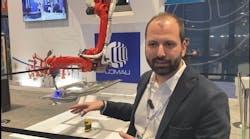I SAW OUR FAVORITE acronym--PLC--in a retail convenience magazine describing PLC-controlled vacuums at local gas stations. The potential uses for PLCs are seemingly endless, the editor writes. Oh my, where has she been?
With the invention of the transistor, microprocessor, and pretty much everything that Hewlett-Packard did, the PLC stands at the pinnacle of our businessas it has for more than 30 years
Dick Morley (widely recognized as the father of the PLC) along with many others who predicted in the '70s' that the PLC would revolutionize our industry, would be proud.
We call it Automation now, and the PLC is at the very heart of this continuing revolution.
Morleys account says the concept of the PLC was born on New Years Day, 1968. In the 70s, folklore had it that it was conceived on the back of a napkin at some greasy spoon in Michigan.
According to other accounts, a few guys at General Motors were trying to replace all those relay panels in the factory with something a little more flexible, so a model change might no longer take a year or more. This thought process reached Morley, as well as some at Allen-Bradley. Although, some will say it might have been the other way around.
Regardless of who did what when, Digital Equipment brought a mini-computer into GM as their PLC. It ultimately was rejected for many reasons, static memory being one of its serious limitations.
Before the PLC, control system problems were many, the least of which was the inordinate amount of time needed to adjust the process when changes were needed.
Does anyone remember the walls of relays, the tangled mass of wires and terminal blocks with outdated prints, and the funky nomenclature to define all those devices? I do. And who can forget all that frustratingly cryptic documentation (via pencil and a T-square) that came from the drafting table?
Troubleshooting, which covered everything from dirty contacts to loose wires to logic racing, was horrendous. The adage, Five hours to find it and five minutes to fix it, was born. Every day as a technician or controls engineer was an adventure.
Over the past 30 years any and all alternatives to an entirely electro-mechanical implementation to address increasingly complex processes started with the PLC.
In my humble recreation of history, Morley didnt develop this on his own. Another fellow who contributed to this phenomena was Odo Struger. Steven Brier, formerly of the New York Times, states in Strugers obituary that Odo invented the PLC.
I had the honor of knowing Odo personally. I participated in a few conference technical sessions with him. He was an avid skier (many times with Morley), an exquisite stock picker, but his passion was technology.
As vice president of technology for Allen-Bradley, he was responsible for the architecture of the companys PLCs as we know them today. This architecture, as Morley puts it, was the second man in, and it won. Today, Rockwell Automation (the company that acquired Allen-Bradley in 1985) has more than 50% of the domestic market.
Morleys company, Modicon, already had a working design. Struger took an existing technology called a Programmable Matrix Controller, and worked that into a PLC framework, which Allen-Bradley then built its automation fortunes on. A fierce battle ensued between Modicon and A-B, and the customers all won.
The PLC as we know it today provided benefits in 1974 as it does now. Flexible programs that create logic states for processes, stored in memory to allow those processes to be more quickly designed and implemented.
A transfer line that took more than nine months to implement, now takes less than a month. Car model changes that took more than two years, now are reduced to less than six months. Startups are measured in days not months, and downtime due to the control system has virtually disappeared. Where the PLC added the most benefit is the ability to expand the process.
Today, we have programming software and tools, HMI, vertical applications and more. Where did those devices come from? Who had the vision and the tenacity to develop all the stuff we use today? Its not much different now--as we will see.
Our thanks to Odo, Dick and the many other pioneers whose innovations allow us to be who we now are.
Stay tuned. I will introduce you to the others here in the months ahead.
| About the Author |
Jeremy Pollard, CET, has been writing about technology and software issues for many years. Publisher of The Software User ONLINE, he has been involved in control system programming and training for more than 20 years. Email him at [email protected].





